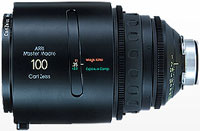|
|
Master Macro for PL mount
For those who want the ultimate in image quality for table top cinematography, product shots, close-up inserts on feature films or any other applications
that require a macro lens, the Master Macro 100 delivers images of breathtaking beauty.
- 100 mm macro lens with 1:1 magnification ratio
- Novel optical design optimized for close-up work
- Wide T-stop range: T2.0 (infinity) / T4.3 (close focus) to T32
- Based on Master Prime technology
- High resolution, high contrast and dramatically reduced flare
- Long focal length allows greater distance to subject
- Built-in Lens Data System (LDS)
- Super Color Matched to Master Primes, Ultra Primes, Ultra 16 lenses, Lightweight Zoom LWZ-1
|


|
Application:
Designed for the ANSI Super 35 image
format, the Master Macro 100 can be used on any PL mount 35 mm film and single sensor digital camera. In addition it can be used on PL mount 16 mm film and single sensor 16 mm or 2/3” format
digital cameras. With a 1:1 magnification ratio, a maximum aperture of T2.0 and an optical design developed specifically for macro work, the Master Macro delivers phenomenally sharp and contrast images with vibrant
colors for extreme close-ups of the highest visual quality.
The use of a spherical lens surfaces and exotic glass types with anomalous partial dispersion greatly reduces chromatic aberration (color fringes). Modern optical design techniques ensure the
optimal light path for reduced stray light and minimized geometric distortion, another feature the Master Macro 100 shares with the Master Primes.
|
Technical Data: |
| Name |
Master Macro T2.0/100 mm |
| Type1 |
Makro-Planar T* XP |
| Lens Mount2 |
PL-LDS |
| Aperture3 |
T2.0/T4.3 to T32 |
| Close Focus4 |
0.35 m / 13 3/4" |
| Magnification ratio5 |
1:1 |
| Length6 |
202.7 mm / 8" |
| Front Diameter7 |
114 mm / 4.5" |
| Weight |
2.6 kg / 5.7 lbs |
| Horizontal angel of view ANSI Super 358 ID = 31.14 mm11 |
14.02° |
| Horizontal angel of view DIN Super 359 ID = 30.00 mm11 |
13.52° |
| Horizontal angel of view Normal 3510 ID = 27.20 mm11 |
12.42° |
| Entrance pupil12 |
77.1 mm / 3" |
(1) T* XP is the trademark of the ZEISS anti-reflection lens coating that significantly reduces veiling glare and other internal reflections.
XP stands for extended performance.
(2) Positive locking 54 mm stainless steel lens mount with Lens Data System (LDS) contacts
(3) Maximum aperture at infinity is T2.0, at close focus T4.3
(4) Close focus is measured from the film/sensor plane
(5) Magnification ratio is the relationship of the size of an object on film (first number) to the size of that object in real life (second number)
(6) Lens length is measured from the lens mount to the front of the lens housing
(7) Diameter of the lens/matte box interface. Maximum lens housing diameter for the Master Macro 100 is 138 mm.
(8) Horizontal angle of view for an ANSI Super 35 Silent camera aperture (aspect ratio 1.33:1, dimensions 24.9mm x 18.7mm / 0.980" x 0.7362")
(9) Horizontal angle of view for a DIN Super 35 Silent camera aperture (aspect ratio 1.33:1, dimensions 24mm x 18mm / 0.944" x 0.7087")
(10) Horizontal angle of view for a Normal 35 Academy camera aperture (aspect ratio 1.37:1, dimensions 22mm x 16mm / 0.8661" x 0.6299")
(11) The image diameter (ID) is the diameter of the image circle needed for the respective format. The Master Macro 100 is designed for the largest ID given here (ANSI Super 35).
(12) The distance from the entrance pupil to the film/sensor plane. Positive numbers indicated an entrance pupil in front, negative numbers indicated an entrance pupil behind the film/sensor plane. The entrance pupil (often mistakenly
called "nodal point") is the center of perspective; moving the camera/lens system around the center of the entrance pupil prevents parallax errors. While largely irrelevant for live action, this measurement is important
for special effects work.
Accessories
Master Diopters
The Master Diopters are a set of three high quality diopters (+0.5, +1 and +2). Their unique mechanical design allows for safe and fast
use, including quick stacking. Close tolerances and a unique clamping mechanism ensure perfect centering.
|
| |
|

